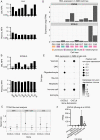Plasma IL-8 and ICOSLG as prognostic biomarkers in glioblastoma
- PMID: 34286278
- PMCID: PMC8284624
- DOI: 10.1093/noajnl/vdab072
Plasma IL-8 and ICOSLG as prognostic biomarkers in glioblastoma
Abstract
Background: CNS immune privilege has been challenged in recent years. Glioblastoma (GBM) immune dysfunction includes complex interactions with the immune system outside the CNS. The aim of this study was to determine diagnostic and prognostic potential of immune-related proteins in plasma in GBM and interrogate biomarker presence in the brain tumor microenvironment (TME).
Methods: One hundred and fifty-eight patients with glioma WHO grade II-IV were included. Plasma collected at surgery was screened for 92 proteins using proximity extension assay technology and related to clinical outcome. Secretion and expression of candidate prognostic biomarkers were subsequently analyzed in 8 GBM cell lines and public RNAseq data.
Results: Plasma levels of 20 out of 92 screened proteins were significantly different in patients with GBM compared to patients with astrocytoma WHO grade II-III. High plasma interleukin-8 (IL-8) (hazard ratio [HR] = 1.52; P = .0077) and low CD244 (HR = 0.36; P = .0004) were associated with short progression-free survival and high plasma IL-8 (HR = 1.40; P = .044) and low ICOS ligand (ICOSLG) (HR = 0.17; P = .0003) were associated with short overall survival (OS) in newly diagnosed patients with GBM. A similar trend was found for ICOSLG (HR = 0.34; P = .053) in recurrent GBM. IL-8 was mostly secreted and expressed by mesenchymal GBM cell lines and expressed by vascular cells and immune cells in the TME. This was also the case for ICOSLG, although less consistent, and with additional expression in tumor-associated oligodendrocytes.
Conclusions: High plasma IL-8 and low ICOSLG at surgery are associated with short OS in newly diagnosed GBM. Source of plasma ICOSLG may be found outside the TME.
Keywords: ICOS ligand; IL-8; circulating biomarkers; glioblastoma.
© The Author(s) 2021. Published by Oxford University Press, the Society for Neuro-Oncology and the European Association of Neuro-Oncology.
Figures


References
-
- Fecci PE, Sampson JH. The current state of immunotherapy for gliomas: an eye toward the future. J Neurosurg. 2019;131(3):657–666. - PubMed
-
- Stupp R, Brada M, van den Bent MJ, Tonn JC, Pentheroudakis G. High-grade glioma: ESMO Clinical Practice Guidelines for diagnosis, treatment and follow-up. Ann Oncol. 2014;25(suppl 3):iii93–iii101. - PubMed
LinkOut - more resources
Full Text Sources
Other Literature Sources
Research Materials
Miscellaneous
